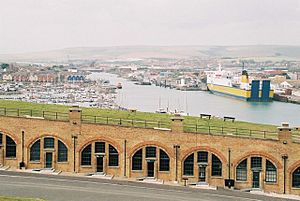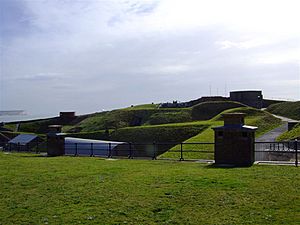Newhaven Fort facts for kids
Quick facts for kids Newhaven Fort |
|
|---|---|
| Lewes East Sussex England |
|

Newhaven Fort - the casemates and the eastern rampart overlooking the harbour
|
|
| Coordinates | 50°46′59″N 0°03′16″E / 50.783184°N 0.054361°E |
| Site information | |
| Owner | Lewes District Council |
| Open to the public |
Yes |
| Site history | |
| Built | 1864-71 |
| In use | Museum |
| Materials | Concrete Brick Earth |
Newhaven Fort is a huge old fort built a long time ago. It was made in the 1800s to protect the harbour at Newhaven. This town is on the south coast of England. It was the biggest defence building ever in Sussex. Today, you can visit it as a museum.
Contents
History of Newhaven Fort
Building the Fort
In 1859, some important people suggested building a new fort. This was to protect the port of Newhaven. A young engineer named John Charles Ardagh helped design it in 1862. He was only 22 years old!
The fort was built on cliffs called Castle Hill. There was already an old gun battery there. Instead of flattening the hill, Ardagh designed the fort to fit the land. This was a clever idea.
A wide ditch, called a moat, protected the fort. It was 40 feet wide! The moat was lined with concrete. This was one of the first times concrete was used so much in a British fort. There was also a secret tunnel leading to a special gun post at the bottom of the cliffs.
The soldiers lived in rooms built into the fort's walls. These were called casemated barracks. The main entrance had a special bridge. Ardagh himself designed and patented this "Equilibrium Bridge."
Building started in 1864. About 250 workers and three steam engines helped. They used shingle from the beach for concrete. They also used clay from nearby for six million bricks! The fort was finished in 1871. The big guns were put in place by 1873.
Newhaven Fort in Action
At first, the fort had powerful 9-inch guns. These guns were special because they could disappear! They would pop up to fire, then hide again. This was the only place in the UK with this type of gun.
Later, around 1906, the fort got newer guns. These were 6-inch naval guns. It also had smaller 12-pounder guns. These smaller guns helped protect against fast enemy boats.
During World War II, the fort was still important. Even newer 6-inch guns were added in 1941. Soldiers from the 521st Coast Regiment manned the fort. They kept watch over the coast.
Saving the Fort
The army left Newhaven Fort in 1962. For a while, people tried to turn it into a business. But that didn't work out.
In 1982, work began to restore the fort. They wanted to make it look like it did in the early 1900s. Some of the old 6-inch guns were put back. Now, Lewes District Council takes care of the fort. It is open for everyone to visit and learn about its history.
Newhaven Fort in Media
The fort's tunnels were shown in a British horror film in 2015. The film was called 'The Cutting Room'.
Also, in the TV show Great British Railway Journeys, Michael Portillo visited the fort. He explored its history and unique features.
Special Events at the Fort
Newhaven Fort also hosts a cool festival called Fort Process. This festival is about sound art. It happened in 2014, 2016, and 2018. Artists use the fort's special rooms and tunnels for their art. The festival helps people enjoy the fort and keep it in good shape.
Images for kids
-
A QF 12-pounder gun at the fort.
See also








